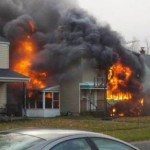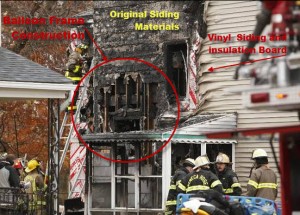Reported Structure Fire with Trapped Occupants: Are YOU Combat Ready?
By Christopher J. Naum, SFPE on Nov 11, 2011 with Comments 0
On any given day, at any given time in the streets, buildings and occupancies that comprise the fabric of our communities and ultimately our response district and first-due areas; the citizens we protect go about their daily lives and activities as we go about ours.
On any given day, at any given time the typical radio transmissions are intervened with a distinction we know all too well when we are called upon to respond to a dispatcher’s punctuated voice, transmitting an alarm for a reported residential structure fire, with trapped civilians.
This is when our training, knowledge and capabilities must be at our highest state of readiness, with expected flawless performance; when we need to expect fire and to ready to go to work. Prepared for the arrival, with the understanding of the incident uncertainty, but with the confidence in our skills and capabilities and those of our company and the balance of the alarm assignment.
Not Today….
 At 07:49 hours on Friday morning November 11, 2011, a 911 call and subsequent dispatch for a reported house fire in a quiet residential neighborhood in West Seneca (Erie County) New York brought fire, law enforcement resources to a residential house fire with initial reports indicated that there were people trapped inside. Numerous Town of West Seneca Police units arrived on scene within minutes of the first call from a neighbor across the street from the residence and reported that the residence was fully engulfed in flames.
At 07:49 hours on Friday morning November 11, 2011, a 911 call and subsequent dispatch for a reported house fire in a quiet residential neighborhood in West Seneca (Erie County) New York brought fire, law enforcement resources to a residential house fire with initial reports indicated that there were people trapped inside. Numerous Town of West Seneca Police units arrived on scene within minutes of the first call from a neighbor across the street from the residence and reported that the residence was fully engulfed in flames.
Witnesses on scene reported that two adolescents had already escaped from the residence through second floor windows, with the assistance of a neighbor, but there were still a mother and her child trapped inside on the second floor. Officers attempted to make entry from several locations around the house, but the fire was so intense, they were repelled by the smoke and intensive heat of the fire.
Fire units from Seneca Hose Fire Company (NY) arrived on scene shortly after the patrols and made entry into the residence under severe fire conditions that had extended rapidly throughout the two story single family residence.
Mother and son die in fire, two escape: wivb.com
The following series of photos captured from video taken by a neighbor illustrate the intensity of the fire as well as the degree of fire involvement that extended through the eight room house. The video clip of initial arriving companies and deployments also exemplifies the conditions encountered by first-due personnel and the need for aggressive and effective assessment, rapid identification of required actions and assignment of resources to task jobs.
This is when each and every member of a fire company, an alarm assignment, a greater alarm resource or a mutual aid unit must be ready to put their training, experience and fortitude to work in the seconds and minutes that will determine the outcome of an incident.
Are you combat ready for engagement? Mentally, Physically, Emotionally and Technicaly?
Preparing for the initial aggressive, time demanding and balanced interior push inward…
Firefighters located an adult, female victim (mother) lying on the floor, just inside the residence front doorway on the alpha division on the number one floor and removed her from the house. Firefighters in a coordinated effort between suppression and rescue personnel continued to search for a second victim and as they battled the intense fire, making their way up to the second floor where they were able to locate an unconscious twelve year old male child in an upstairs bedroom, and removed him from the house. Both victims were determined to be deceased at the scene according to published news reports.
Two other occupants, a twenty year old sister and her 15 year old brother who escaped through second floor windows were taken to the hospital and are expected to be released. Additionally, two firefighters from Seneca Hose Fire Company received minor burns during the search for the victims and were also transported to the hospital for treatment. The cause of the fire is under investigation.
Combat Ready
In this incident, the favorable outcome that we always hope for could not be achieved by the operating departments. The media coverage and video clips depict a rapidly developing fire that became self-revealing with intensity and magnitude that is not typically common for this type and style of residential dwelling given the time of day and the sequence of observations and conditions reported by the neighbors. Further insights will certainly be identifed following the investigations.
It is evident and apparent through observation of the videos and images of flame propagation and smoke development (color, density and pressure) that the fire’s intensity, rate of growth and extension created a very hostile interior environment in which survivability time could diminish rapidly under various conditions proximal to the flames and smoke exposure for civilians in distress, trapped or incapacitated.
The challenges presented by this fire, although not uncommon; did present demands on the initial and subsequent arriving company officers, firefighters and command officers. Rapid fire growth and extension, deteriorating interior conditions, uncertainty of building performance and stability, immediate resource needs, time pressures, multiple operational demands and known trapped civilians-including a child provide all the ingredients that we train and prepare for; this is our job, these are our [potential] expectations when we respond to reports of a structure fire in an occupied dwelling.
The fire departments and personnel who operated and performed at this incident appear to have performed with exceptional fortitude and in the rich tradition of what defines the American Fire Service. They did what was expected of them and without serious injury to operating personnel. But this article isn’t about dissecting or analyzing their performance or providing criticism. It’s an opportunity to provide some focused insights with supporting visuals, an actual incident account and a typical fire: one of over 1320 structure fires that occurs each and every day across this country (See Thecompanyofficer.com HERE for recent NFPA stats).
This is an incident with a given set of challenging conditions that we should be training and preparing for each and every day. It’s why we exist, it’s the fundamental basis and principle of what we should be capable of providing to our communities and response districts.
The operative question is this: Are you combat ready and prepared to engage?
It’s apparent the firefighters in Erie County (NY) were today, with a profound sense of duty, courage and fortitude.
But are you? There’s been a lot written, presented and discussed on being combat ready, knowing your role and responsibilities, having the appropriate blend of competencies, skills, knowledge and experience.
Knowing with a degree of depth, your job and performing on each run, on every call without exception. Being able to orchestrate and coordinate required activities and tasks in a timely manner with other resources, companies, personnel and teams while maintaining a balanced mental state, broad-based situational awareness and forward thinking perspective on each activity whether strategic, tactical or task oriented based.
There comes a time; when a single call or the associated demands of a shift or tour that is defined by frequent and repetitive call demands that define you as a firefighter, company officer or commander.
Be combat ready for engagement each and every call; be prepared and ready to implement with those attributes that define you, your company and your department; when it may be needed the most. Implement an adaptive fireground management process, maintaining a balance for tactical patience and the need for defined and educated aggressive actions (smart firefighting).
Are you combat ready for engagement? Mentally, Physically, Emotionally and Technicaly?
- If you are? How can you provide continuous improvements and enhancements?
- If, not; what do you need to do? On a personal level, company, station, battalion, division, department , county or regional level?
Some Broad based Operational Insights [Selective]
- Define the Building and Occupancy Profile
- When capable perform the 360 degree
- Consider the size and volume of the structure
- Identify the structural systems
- Respect the floor and roof support systems
- Assume the level of compartmentation
- Think about Occupancy Risk versus Occupancy Type
- Read the Smoke and Fire: Understand what you’re seeing
- Be sensitive to collapse and compromise
- Practice rapid risk assessment
- Acknowledge the needs of civilians in distress
- Don’t get paralyzed by multiple demands
- Don’t get trapped at the tactical level of operations
- Have the required resources necessary to do the job
- Maintain an objective and broad based incident perspective
- Think five steps ahead of any point of reference or milestone
- Don’t lose track of time and get displaced
- Don’t assume you have time; it’s not on your side
- Consider fire dynamics and fire behavior
- Maintain Situational Awareness
- Consider fire flows and delivery rates
- Be prepared to be confronted by FIRE
- Trust your firefighters, company officers and commanders
- Controlling or mitigating the fire: Simplifies everything else
- Ladder everything and everywhere
- Consider Tactical Patience [But];
- Implement aggressive smart firefighting when needed
- Demand Safety Conscious Work Practices
- Default on your experience and training
- Use Adaptive Fireground Management
- Be aware of Command Compression
- Practice Intelligent Firefighting
- Courage to be Safe
- Coordinate Operations
- Respect the Fire
- Have a Plan
- Communicate
- Be a Firefighter: that’s what we do
- Understand [your] Limitations
- Know your district
- Be Safe
Additional Links:
- http://www.buffalonews.com/city/communities/west-seneca/article628411.ece
- http://www.msnbc.msn.com/id/45255986/ns/local_news-buffalo_ny/
- http://www.wivb.com/dpp/news/local/mother-and-son-die-in-fire%2C-two-escape?ref=scroller&categoryId=10001&status=true
- http://www.wivb.com/dpp/news/erie/unforgiving-flames-stun-quiet-community
Operational Considerations: The House
- The house was a Single Family Residential (SFR) of Type V wood frame construction
- Built in 1952, Balloon Frame Construction, remodeled in early 1970’s (according to public records)
- Vinyl Siding added over insulation board attached to existing siding
- Two Story
- Detached Garage
- Eight (8) Rooms
- 1.5 baths
- 1,737 square feet (SF)
- Residential neighborhood
- Full division access from street
- Hydrant service area
- Property Setbacks to exposures ( B and D)
- Alpha Division: Street
- Bravo Divison: House (similar Type V)
- Charlie Division: Open Yard
- Delta Division: House (similar Type V)
- 360 degree accessible
- Limited windows on Bravo and Delta sides
Filed Under: Adaptive Fireground Management • BuildingsonFire • Combat Fire Engagement • Featured • Fill the Box • Predictive Occupancy Performance































